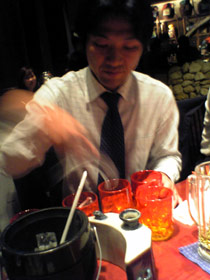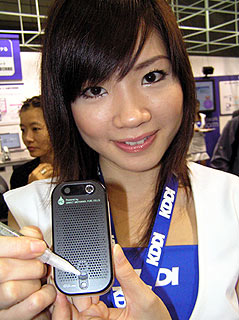 On Friday, the MIJ team wrapped up the October mission to Tokyo and headed home to the Heartland for happy hour and some relaxed networking; everyone was pooped but delighted with the program (so said the team, not me the organiser!).
On Friday, the MIJ team wrapped up the October mission to Tokyo and headed home to the Heartland for happy hour and some relaxed networking; everyone was pooped but delighted with the program (so said the team, not me the organiser!).
After a full day Wednesday at CEATEC to view fuel-cell mobile batteries, digital-TV handsets and a super new satellite pocket rocket from DoCoMo, we spent Thursday and Friday back on the MIJ agenda, meeting with, respectively, an LBS application developer, a major content aggregator, an alternative mobile payment provider (to find out what to do when your content is just too pricey for the official menus), a mobile marketing manager and a 3G carrier, among others. Thursday evening was another highlight as we met with Andrew Shuttleworth, one of Tokyo’s most knowledgeable and opinionated mobile application usability gurus, and a trio of young, female, non-tech Japanese college students who utterly tore apart preconceived notions of why Japanese use mobile like they do. (What? You mean you don’t like to pay for content??)
Listen to WWJ’s Lawrence Cosh-Ishii and Daniel Scuka begin_of_the_skype_highlighting end_of_the_skype_highlighting on Dave Graveline’s “Into Tomorrow” live at CEATEC; from 11:00-mark via MP3 Here.


 On Friday, the MIJ team wrapped up the October mission to Tokyo and headed home to the
On Friday, the MIJ team wrapped up the October mission to Tokyo and headed home to the 
 President Nakamura faced the Tokyo press on September 30 and did… not too bad a job. In a wide-ranging presentation followed by Q&A, he covered fuel cell R&D (commercialization after FY 2006), Softbank’s moves to obtain 3G spectrum (vacating the spectrum tomorrow “cannot be done”), and Big D’s global strategy (with a dual-mode GSM/W-CDMA handset, you can access both). Nakamura also talked about churn, competition with KDDI/au, and the possibility of abandoning pre-paid services. A post-fall IR Roadshow program that’s not to be missed.
President Nakamura faced the Tokyo press on September 30 and did… not too bad a job. In a wide-ranging presentation followed by Q&A, he covered fuel cell R&D (commercialization after FY 2006), Softbank’s moves to obtain 3G spectrum (vacating the spectrum tomorrow “cannot be done”), and Big D’s global strategy (with a dual-mode GSM/W-CDMA handset, you can access both). Nakamura also talked about churn, competition with KDDI/au, and the possibility of abandoning pre-paid services. A post-fall IR Roadshow program that’s not to be missed.